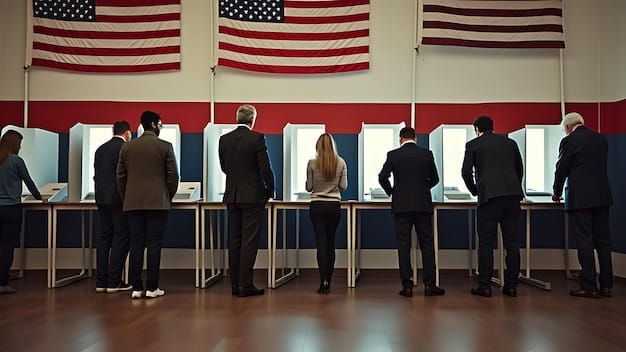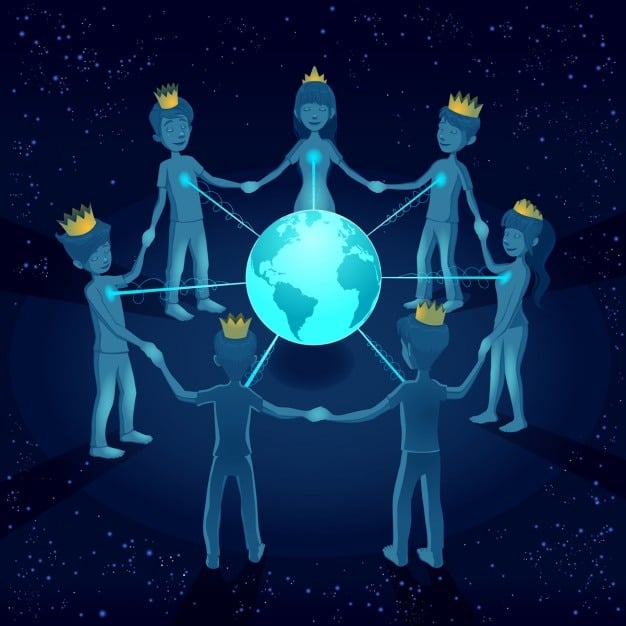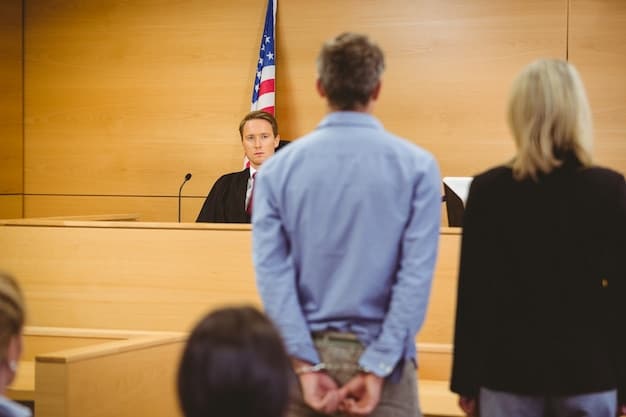US Diplomatic Efforts: Addressing Human Rights Concerns in 2025

In 2025, the U.S. addresses human rights concerns through diplomatic channels by engaging in bilateral dialogues, supporting international organizations, imposing targeted sanctions, and promoting human rights education and advocacy programs globally.
The United States has long prioritized human rights as a cornerstone of its foreign policy. As we look ahead to 2025, understanding
The Evolving Landscape of Human Rights Diplomacy
The nature of diplomacy is constantly evolving, influenced by technological advancements, geopolitical shifts, and changing societal norms. In the context of human rights, this evolution demands that the U.S. adapt its strategies to remain effective in promoting and protecting fundamental rights around the world.
Several factors contribute to this evolving landscape. The rise of digital authoritarianism, the spread of disinformation, and the increasing influence of non-state actors all present new challenges for human rights diplomacy. Additionally, shifting alliances and geopolitical tensions require the U.S. to carefully calibrate its approach to different countries and regions.
Key Trends Shaping Human Rights Diplomacy in 2025
Understanding the trends that are shaping human rights diplomacy is crucial for assessing the U.S.’s approach in 2025. These trends include:
- The increasing use of technology to monitor and suppress dissent.
- The growing prominence of economic statecraft as a tool for influencing human rights practices.
- The rise of populism and nationalism, which often leads to restrictions on civil liberties and the targeting of minority groups.
- The impact of climate change on human rights, particularly in vulnerable communities.
Considering these trends, the U.S. must employ a multi-faceted approach that combines traditional diplomatic tools with innovative strategies to address human rights concerns effectively.

In response to these evolving challenges, the U.S. is likely to prioritize:
- Strengthening partnerships with like-minded countries and international organizations.
- Investing in digital tools and platforms to promote freedom of expression and combat disinformation.
- Supporting civil society organizations that are working to protect human rights on the ground.
- Using targeted sanctions and other economic measures to hold human rights abusers accountable.
By proactively adapting to the changing landscape of human rights diplomacy, the U.S. can maintain its leadership role in promoting and protecting fundamental rights globally.
In conclusion, the evolving landscape of human rights diplomacy requires the U.S. to be agile, innovative, and collaborative in its approach, ensuring that it can effectively address emerging challenges and promote human rights around the world.
Bilateral Dialogues and Engagements
One of the primary ways the U.S. addresses human rights concerns is through direct engagement with other countries. This often takes the form of bilateral dialogues, where U.S. officials meet with their counterparts to discuss specific human rights issues and press for reforms.
These dialogues can be formal or informal, and they may take place at various levels of government. The effectiveness of bilateral dialogues depends on several factors, including the political will of the countries involved, the credibility of the U.S. as a human rights advocate, and the ability to leverage other forms of pressure, such as economic sanctions or visa restrictions.
Examples of Successful Bilateral Engagements
Throughout history, the U.S. has had some success using bilateral engagements to advance human rights. Some notable examples include:
- The promotion of religious freedom in countries with discriminatory laws.
- The release of political prisoners in authoritarian regimes.
- The improvement of labor standards in developing countries.
However, it’s essential to acknowledge that bilateral engagements are not always successful, and they can be challenging to implement effectively.
In 2025, the U.S. is likely to prioritize bilateral engagements with countries where there is a clear opportunity to make progress on human rights. This may involve focusing on specific issues or working with reform-minded individuals within the government.

To enhance the effectiveness of bilateral dialogues, the U.S. should:
- Ensure that dialogues are well-prepared and based on accurate information.
- Involve civil society organizations and human rights defenders in the process.
- Be prepared to use other forms of pressure if dialogues fail to produce results.
Bilateral dialogues remain a crucial tool for the U.S. in promoting human rights globally, but they must be implemented strategically and with a clear understanding of their limitations.
In essence, bilateral dialogues and engagements are a key component of U.S. human rights diplomacy, providing a direct and often nuanced approach to addressing concerns and promoting reforms in specific countries.
Supporting International Organizations and Treaties
Beyond bilateral engagements, the U.S. also works through international organizations and treaties to advance human rights. These organizations, such as the United Nations, provide a forum for countries to discuss human rights issues and develop common standards.
International treaties, such as the International Covenant on Civil and Political Rights, create legally binding obligations for countries that ratify them. The U.S. has played a significant role in shaping international human rights law, even though it has not ratified all major human rights treaties.
The U.S. Role in the UN Human Rights System
The U.S. is a member of the UN Human Rights Council, which is responsible for promoting and protecting human rights around the world. The U.S. uses its seat on the Council to:
- Raise awareness of human rights violations in specific countries.
- Support resolutions that condemn human rights abuses.
- Work with other countries to strengthen the UN human rights system.
However, the U.S. has also been critical of the Council, particularly its perceived bias against certain countries and its failure to hold some of the world’s worst human rights abusers accountable.
In 2025, the U.S. is likely to continue to engage with the UN Human Rights system, but it may also explore other avenues for promoting human rights multilaterally. This could involve working with regional organizations or forming ad hoc coalitions with like-minded countries.
To strengthen its role in supporting international organizations and treaties, the U.S. should:
- Ratify additional human rights treaties, demonstrating its commitment to international law.
- Work with other countries to reform the UN Human Rights Council, ensuring its effectiveness and impartiality.
- Provide financial and technical assistance to international organizations that are working to protect human rights.
By actively supporting international organizations and treaties, the U.S. can leverage the collective power of the international community to promote human rights globally.
Ultimately, supporting international organizations and treaties is vital for the U.S. to amplify its human rights efforts and foster a global commitment to protecting fundamental rights.
Targeted Sanctions and Economic Measures
In situations where diplomatic engagement and international pressure are insufficient, the U.S. may resort to targeted sanctions and other economic measures to address human rights concerns. These measures are designed to punish individuals and entities responsible for human rights abuses, while minimizing the impact on innocent civilians.
Targeted sanctions may include asset freezes, travel bans, and restrictions on financial transactions. Economic measures may include trade restrictions, investment bans, and the suspension of aid programs.
The Effectiveness of Targeted Sanctions
The effectiveness of targeted sanctions is a subject of ongoing debate. Some studies have shown that sanctions can be effective in achieving specific human rights goals, such as:
- The release of political prisoners.
- The cessation of violence against civilians.
- The dismantling of repressive institutions.
However, other studies have found that sanctions are often ineffective and can have unintended consequences, such as harming vulnerable populations or driving human rights abuses underground.
In 2025, the U.S. is likely to continue to use targeted sanctions and economic measures as a tool for promoting human rights, but it will need to carefully consider the potential impact of these measures and ensure that they are implemented in a way that maximizes their effectiveness and minimizes harm.
To improve the effectiveness of targeted sanctions, the U.S. should:
- Conduct thorough assessments of the potential impact of sanctions before they are imposed.
- Coordinate sanctions with other countries to ensure that they are not undermined.
- Provide humanitarian assistance to mitigate the impact of sanctions on vulnerable populations.
Targeted sanctions and economic measures can be a valuable tool for promoting human rights, but they must be used judiciously and with a clear understanding of their potential limitations.
In summary, targeted sanctions and economic measures represent a forceful approach by the U.S. to address human rights violations, requiring careful consideration and strategic implementation to achieve desired outcomes without causing undue harm.
Promoting Human Rights Education and Advocacy
In addition to diplomatic and economic measures, the U.S. also plays a role in promoting human rights education and advocacy around the world. This involves supporting programs that raise awareness of human rights, empower civil society organizations, and train human rights defenders.
Human rights education can take many forms, from formal education programs in schools and universities to informal training workshops for community leaders and activists. Advocacy involves working to change laws, policies, and practices that violate human rights.
The Role of U.S. Government Agencies
Several U.S. government agencies are involved in promoting human rights education and advocacy, including:
- The Department of State, which funds human rights programs through its foreign assistance budget.
- The U.S. Agency for International Development (USAID), which supports civil society organizations that are working to protect human rights.
- The National Endowment for Democracy (NED), which provides grants to organizations that are promoting democracy and human rights around the world.
These agencies work with a wide range of partners, including international organizations, local non-governmental organizations, and individual activists.
In 2025, the U.S. is likely to increase its focus on promoting human rights education and advocacy, particularly in countries where there is a shrinking space for civil society. This may involve providing technical assistance to human rights defenders, supporting independent media outlets, and using digital tools to bypass censorship.
To strengthen its efforts in promoting human rights education and advocacy, the U.S. should:
- Increase funding for human rights programs through its foreign assistance budget.
- Provide greater support to civil society organizations that are working to protect human rights.
- Work with technology companies to develop tools that can help human rights defenders bypass censorship and surveillance.
By investing in human rights education and advocacy, the U.S. can help to create a more just and equitable world where everyone can enjoy their fundamental rights.
In conclusion, promoting human rights education and advocacy is a vital component of U.S. human rights diplomacy, empowering individuals and communities to defend their rights and hold their governments accountable.
Addressing Emerging Challenges and Future Directions
Looking ahead to 2025 and beyond, the U.S. will need to confront a number of emerging challenges in the field of human rights. These challenges include:
Climate change, which has a disproportionate impact on vulnerable populations and can exacerbate existing human rights problems. The rise of digital authoritarianism, which allows governments to monitor and control their citizens in unprecedented ways. The spread of disinformation, which can undermine democratic institutions and erode trust in human rights norms.
Strategies for Addressing Emerging Challenges
To address these challenges, the U.S. will need to adopt a more holistic and integrated approach to human rights diplomacy. This may involve:
- Integrating human rights considerations into all aspects of its foreign policy, including trade, security, and development.
- Working with other countries to develop international norms and standards for the digital age.
- Investing in programs that promote media literacy and combat disinformation.
Additionally, the U.S. will need to strengthen its partnerships with civil society organizations, which play a crucial role in monitoring human rights abuses and advocating for change.
In 2025, the U.S. is likely to prioritize:
- Developing strategies for addressing the human rights implications of climate change.
- Working with technology companies to protect freedom of expression and privacy online.
- Supporting efforts to promote accountability for human rights abuses committed in cyberspace.
By proactively addressing emerging challenges and adapting its strategies to the changing global landscape, the U.S. can maintain its leadership role in promoting and protecting human rights for generations to come.
In summary, addressing emerging challenges requires the U.S. to be proactive, innovative, and collaborative in its human rights diplomacy, ensuring that it can effectively tackle new threats and promote fundamental rights in a rapidly changing world.
| Key Point | Brief Description |
|---|---|
| 🤝 Bilateral Dialogues | Direct talks with countries to address specific concerns. |
| 🌍 International Support | Working with organizations like the UN to set standards. |
| ⛔ Targeted Sanctions | Using economic measures to penalize human rights abusers. |
| 📚 Education & Advocacy | Promoting awareness and support for human rights globally. |
FAQ
▼
Sanctions are used to penalize human rights abusers, aiming to halt violations. They target individuals and entities, restricting access to financial systems and international travel to pressure for change.
▼
The US engages in the UN Human Rights Council, advocating for resolutions, raising awareness, and promoting reforms. It contributes to global standards and supports initiatives for human rights protection.
▼
Bilateral dialogues are direct talks with other countries, allowing the US to address concerns and press for reforms. They are crucial for tailored diplomatic engagement and achieving specific human rights goals.
▼
The US supports programs that raise awareness, empower civil society, and train human rights defenders. USAID funds human rights NGOs, and this education helps foster a global culture of rights.
▼
Challenges include climate change impacts, digital authoritarianism, and the spread of disinformation. Addressing these requires holistic strategies and international cooperation to protect human rights.
Conclusion
In 2025, the US employs a multifaceted approach to address human rights concerns, integrating diplomacy, economic measures, and support for international norms. By adapting to emerging challenges and fostering global collaboration, the US aims to promote and protect fundamental rights worldwide.





